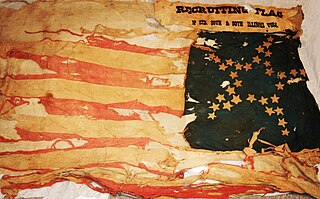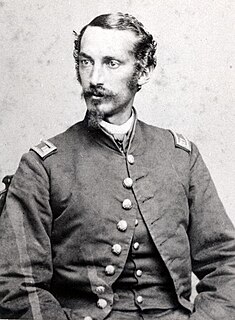
The Colditz Story is a 1955 prisoner of war film starring John Mills and Eric Portman and directed by Guy Hamilton. It is based on the book written by Pat Reid, a British army officer who was imprisoned in Oflag IV-C, Colditz Castle, in Germany during the Second World War and who was the Escape Officer for British POWs within the castle.

The Andersonville National Historic Site, located near Andersonville, Georgia, preserves the former Camp Sumter, a Confederate prisoner-of-war camp during the final twelve months of the American Civil War. Most of the site lies in southwestern Macon County, adjacent to the east side of the town of Andersonville. As well as the former prison, the site contains the Andersonville National Cemetery and the National Prisoner of War Museum. The prison was made in February 1864 and served to April 1865.

Castle Thunder, located between what is now 17th Street and 18th Street on northern side of E Cary Street in Richmond, Virginia, was a former tobacco warehouse, located on Tobacco Row, converted into a prison used by the Confederacy to house civilian prisoners, including captured Union spies, political prisoners and those charged with treason during the American Civil War. A large number of its inmates were sentenced to death. Even though the inmates were sometimes allowed boxes of medicine and other supplies, the prison guards had a reputation for brutality.

Cahaba Prison, also known as Castle Morgan, was a prisoner of war camp in Dallas County, Alabama where the Confederacy held captive Union soldiers during the American Civil War. The prison was named Castle Morgan after Cahaba lawyer and Confederate Brigadier General John Tyler Morgan. The prison was located in the small Alabama town of Cahaba, at the confluence of the Alabama and Cahaba rivers, not far from Selma. It suffered a serious flood in 1865. At the time, Cahaba was still the county seat, but that was moved to Selma in 1866. Cahaba Prison was known for having one of the lowest death rates of any Civil War prison camp mainly because of the humane treatment from the Confederate commandant.

Camp Douglas, in Chicago, Illinois, sometimes described as "The North's Andersonville," was one of the largest Union Army prisoner-of-war camps for Confederate soldiers taken prisoner during the American Civil War. Based south of the city on the prairie, it was also used as a training and detention camp for Union soldiers. The Union Army first used the camp in 1861 as an organizational and training camp for volunteer regiments. It became a prisoner-of-war camp in early 1862. Later in 1862 the Union Army again used Camp Douglas as a training camp. In the fall of 1862, the Union Army used the facility as a detention camp for paroled Confederate prisoners.

Johnson's Island is a 300-acre (120 ha) island in Sandusky Bay, located on the coast of Lake Erie, 3 miles (4.8 km) from the city of Sandusky, Ohio. It was the site of a prisoner-of-war camp for Confederate officers captured during the American Civil War. Initially, Johnson's Island was the only Union prison exclusively for Confederate officers but eventually held privates, political prisoners, persons sentenced to court martial and spies. Civilians who were arrested as guerrillas, or bushwhackers, were also imprisoned on the island. During its three years of operation, more than 15,000 men were incarcerated there.

Thomas Henry Hines was a Confederate cavalryman who was known for his spying activities during the last two years of the American Civil War. A native of Butler County, Kentucky, he initially worked as a grammar instructor, mainly at the Masonic University of La Grange, Kentucky. During the first year of the war, he served as a field officer, initiating several raids. He was an important assistant to John Hunt Morgan, doing a preparatory raid in advance of Morgan's Raid through the states of Indiana and Ohio, and after being captured with Morgan, organized their escape from the Ohio Penitentiary. He was later involved in espionage and tried to stir up insurrections against the Federal government in selected Northern locales.

The 80th Illinois Volunteer Infantry Regiment was an infantry regiment that served in the Union Army during the American Civil War. The regiment was composed of ten companies that drew primarily from eight southern Illinois counties. Over the course of the war the regiment traveled approximately 6,000 miles, and was in over 20 battles.

Camp Morton was a military training ground and a Union prisoner-of-war camp in Indianapolis, Marion County, Indiana, during the American Civil War. It was named for Indiana governor Oliver Morton. Prior to the war, the site served as the fairgrounds for the Indiana State Fair. During the war, Camp Morton was initially used as a military training ground. The first Union troops arrived at the camp in April 1861. After the fall of Fort Donelson and the Battle of Shiloh, the site was converted into a prisoner-of-war camp. The first Confederate prisoners arrived at Camp Morton on February 22, 1862; its last prisoners were paroled on June 12, 1865. At the conclusion of the war, the property resumed its role as the fairgrounds for the Indiana State Fair. In 1891 the property was sold and developed into a residential neighborhood known as Morton Place, a part of the Herron-Morton Place Historic District.
A large contingent of African Americans served in the American Civil War. 186,097 black men joined the Union Army: 7,122 officers, and 178,975 enlisted soldiers. Approximately 20,000 black sailors served in the Union Navy and formed a large percentage of many ships' crews. Later in the War, many regiments were recruited and organized as the "United States Colored Troops", which reinforced the Northern side substantially in the last two years. Both Northern free blacks and Southern runaway slaves joined the fight. Throughout the course of the war, black soldiers served in forty major battles and hundreds of more minor skirmishes; sixteen African Americans received the Medal of Honor.
The Immortal Six Hundred were 600 Confederate officers that were held prisoner by the Union Army in 1864-65. They were intentionally starved and 46 died as a result. They are known as the "Immortal Six Hundred" because they refused to take an oath of allegiance to the U.S. under duress.

The Beefsteak Raid was a Confederate cavalry raid that took place in September 1864 as part of the Siege of Petersburg during the American Civil War. Confederate Maj. Gen. Wade Hampton led a force of 3,000 troopers of the Confederate States Army on what was to become a 100-mile (160 km) ride to acquire cattle that were intended for consumption by the Union Army, which was laying a combined siege to the cities of Richmond and Petersburg, Virginia.

John Henry Winder was a career United States Army officer who served with distinction during the Mexican–American War. He later served as a Confederate general officer during the American Civil War.

Hispanics in the American Civil War fought on both the Union and Confederate sides of the conflict. Not all the Hispanics who fought in the American Civil War were "Hispanic-Americans", in other words citizens of the United States. Many of them were Spanish subjects or nationals from countries in the Caribbean, Central and South America. Some were born in a US Territory and therefore did not have the right to US Citizenship. It is estimated that approximately 3,500 Hispanics, mostly Mexican-Americans, Puerto Ricans and Cubans living in the United States joined the war: 2,500 for the Confederacy and 1,000 for the Union. This number increased to 10,000 by the end of the war.

Harrison Carroll Hobart was a colonel in the Union Army during the American Civil War and a lawyer and politician in the state of Wisconsin.

Federico Fernández-Cavada Howard was an officer in the Union Army during the American Civil War and a diplomat, as well as commanding forces in Cuba's Ten Years' War. Because of his artistic talents, he was assigned to the Hot Air Balloon unit of the Union Army. From the air he sketched what he observed of enemy positions and movements. On April 19, 1862, Fernández Cavada sketched enemy positions from Thaddeus Lowe's Constitution balloon during the Peninsular Campaign in Virginia.

American Civil War Prison Camps were operated by both the Union and the Confederacy to handle the 409,000 soldiers captured during the war from 1861 to 1865. The Record and Pension Office in 1901 counted 211,000 Northerners who were captured. In 1861-63 most were immediately paroled; after the parole exchange system broke down in 1863, about 195,000 went to prison camps. Some tried to escape but few succeeded. By contrast 464,000 Confederates were captured and 215,000 imprisoned. Over 30,000 Union and nearly 26,000 Confederate prisoners died in captivity. Just over 12% of the captives in Northern prisons died, compared to 15.5% for Southern prisons.

Ivan N. Walker was an American soldier who served in the Union Army during the American Civil War and as the 24th Commander-in-Chief of the Grand Army of the Republic, 1895-1896.

The Wytheville Raid or Toland's Raid was an attack by an undersized Union brigade on a Confederate town during the American Civil War. Union Colonel John Toland led a brigade of over 800 men against a Confederate force of about 130 soldiers and 120 civilians. The location of Wytheville, the county seat of Wythe County in southwestern Virginia, had strategic importance because of a nearby lead mine and the railroad that served it. This mine supplied lead for about one third of the Confederate Army's munitions, while the Virginia & Tennessee Railroad transported Confederate troops and supplies; plus telegraph wires along the railroad line were vital for communications. In addition to logistics of moving the lead to bullet manufacturing facilities, this rail line also connected an important salt works of an adjacent county with the wider Confederacy.























